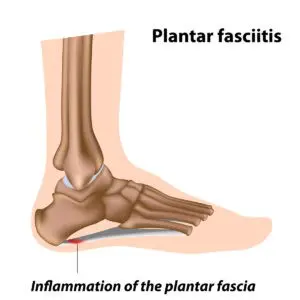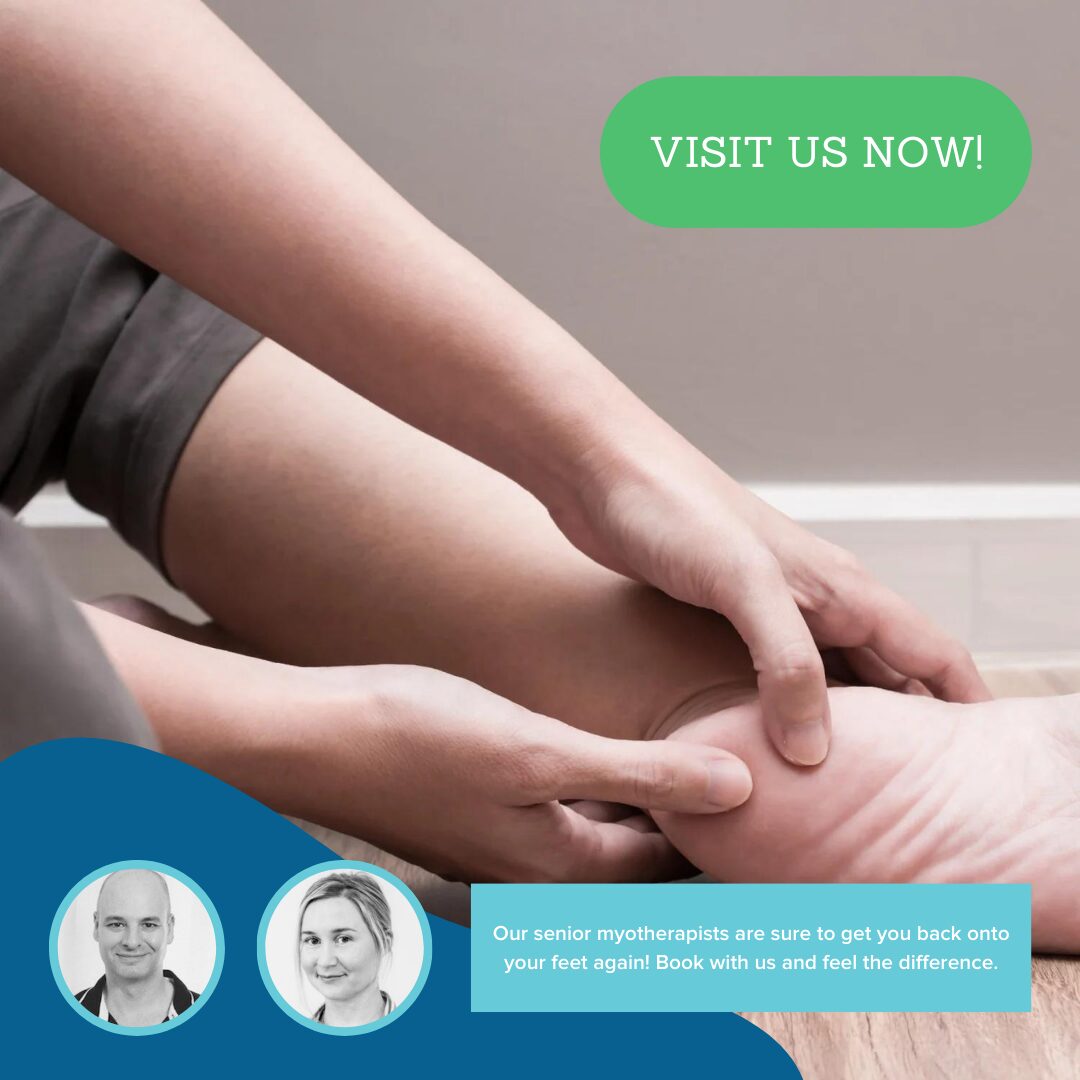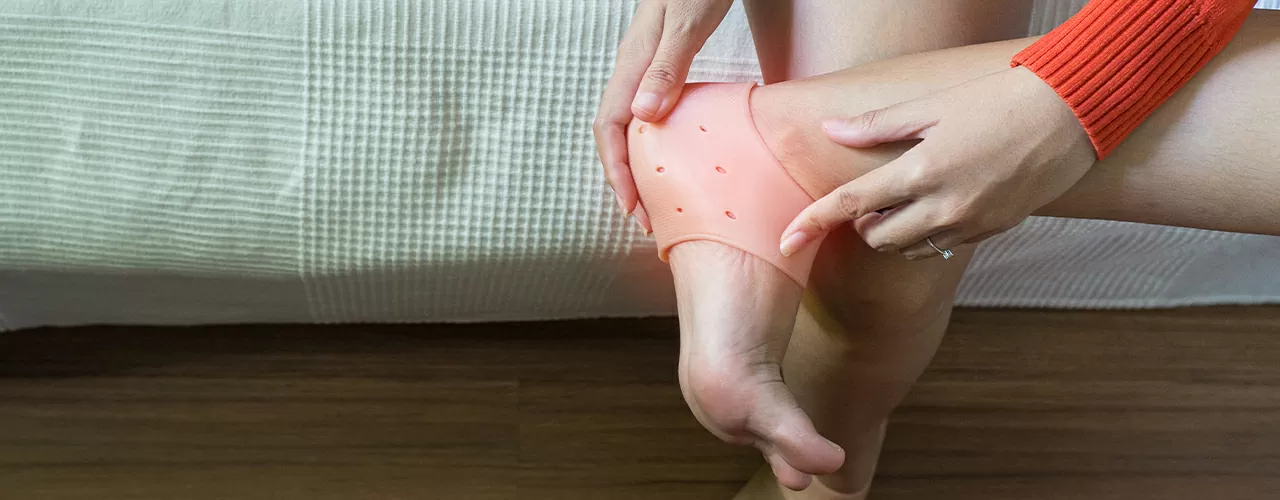What’s Plantar Fasciitis?
Plantar Fasciitis is an overuse injury caused by micro trauma to the Plantar Fascia – a tendinous attachment beneath the foot. 10% of the population will have plantar fasciitis at any given time.
What causes Plantar Fasciitis to flare up?
Plantar Fascia pain is caused by micro tearing of the tendon at the heel – this is known as a tendinopathy. A tendinopathy is an irritation to the the tendon that becomes damaged, but doesn’t have time to heal before it suffers more irritation.

People at risk of Plantar Fasciitis tend to be on their feet a lot:
- school teachers
- runners (third most common running injury)
- nurses
- hospitality workers
- high body mass (50% risk increase)
Hormonal change in middle age can also weaken the collagen structure of the tendon – which increases the risk of tendinopathies like plantar fasciitis.
Footwear contributes a lot to plantar fasciitis. Many studies have shown rapid improvement in studies, just by inserting a $20 silicon heel pad into your shoes.
What Plantar Fasciitis feels like?
- Pain with the first few steps after rest (typically the morning)
- Pain with increased physical exercise
- Pain with prolonged standing
Plantar Fasciitis is usually noticeable on the first few steps after rest or being seated. The pain is frequently described as “like walking on broken glass” – especially in the morning.
Left untreated, plantar fasciitis has been associated with heel spurs, a calcified growth in the heel which is excruciatingly painful to walk on.
Reduce Your Pain at Home!
What shouldn’t I do for Plantar Fasciitis?
- Don’t get cortisone injections. Cortisone may provide temporary relief but has been proven to weaken the collagen of the tendon more – creating a CHRONIC problem.
- Don’t ignore the symptoms – it can take up to 2 years for the condition to resolve on its own – if you work on your feet or are a high body mass individual – plantar fasciitis may never ease without clinical intervention.
Who should you see for plantar fasciitis?
The sooner you act on heel pain caused by plantar fasciitis, the easier it is to resolve. The first person you should see is a Remedial Massage Therapist for Expert Plantar Fasciitis Massage. Changing the muscle tension in the lower leg, learning the best stretches to keep the lower leg muscles loose, finding the best exercise to improve the angry reactive tendon causing the pain and learning about a heel pad will make a long painful journey much, much shorter.
Get back on your feet again with an Expert Remedial Plantar Fasciitis Massage!

Plantar Fasciitis treatment – are massages good for plantar fasciitis?
- Expert plantar fasciitis massage can immediately reduce plantar fasciitis pain by reducing muscular tension in the calves which are causing tension in the plantar fascia tendon.
- Rubbing the plantar fascia itself is of limited value, however releasing the muscle tension in the lower leg will usually have an immediate impact on pain reduction.
- A remedial massage therapist can show you how to keep your calves from becoming tight again after your plantar fasciitis massage.
- Performing simple modified calf raises has been PROVEN to change the pain generating chemical makeup in the reactive tendon. Without going into biochemistry too deeply, these exercises help make the collagen of the tendon more stable and able to withstand load – while immediately reducing pain
- Over the counter heal inserts have been shown to de-load the plantar fascia and resolve pain in early plantar fasciitis.
Long standing Plantar Fasciitis (12months or longer) – particularly where excess weight is a contributing factor – will require orthotics to made by a podiatrist.
https://www.mayoclinic.org/tests-procedures/neurogenic-bladder-bowel-management/about/pac-
20394763
https://www.mayoclinic.org/medical-professionals/digestive-
diseases/news/diagnosis-and-management-of-patients-with-chronic-
constipation/mqc-20485152
https://www.mayoclinic.org/diseases-conditions/constipation/diagnosis-
treatment/drc-20354259
https://tacanow.org/family-resources/the-poop-page/
https://www.ouh.nhs.uk/patient-guide/leaflets/files/49007Pfasciitis.pdf
https://sma.org.au/resources-advice/injury-fact-sheets/plantar-fasciitis/
https://www.mayoclinic.org/diseases-conditions/plantar-fasciitis/symptoms-causes/syc-20354846
https://newsnetwork.mayoclinic.org/discussion/mayo-clinic-q-and-a-treating-plantar-fasciitis/
https://www.betterhealth.vic.gov.au/health/conditionsandtreatments/foot-problems-heel-pain
https://www.healthdirect.gov.au/plantar-fasciitis
https://www.abc.net.au/radio/hobart/programs/saturdays/air:-medical-matters—plantar-fasciitis/11126060
https://www.nytimes.com/guides/well/activity/treat-plantar-fasciitis
https://www.latrobe.edu.au/news/articles/2019/release/heel-pain-to-jab-or-not-to-jab
Related Posts
Lymphatic Drainage Massage Benefits
Lymphatic Drainage Massage Benefits
Lymphatic Compression Pump Therapy Brisbane
Frequently Asked Questions (FAQs)
- Expert plantar fasciitis massage can immediately reduce plantar fasciitis pain by reducing muscular tension in the calves which are causing tension in the plantar fascia tendon.
- Rubbing the plantar fascia itself is of limited value, however releasing the muscle tension in the lower leg will usually have an immediate impact on pain reduction.
- A remedial massage therapist can show you how to keep your calves from becoming tight again after your plantar fasciitis massage.
Absolutely.
- Plantar Fasciitis is an overuse injury caused by micro trauma to the Plantar Fascia – a tendinous attachment beneath the foot. 10% of the population will have plantar fasciitis at any given time.
- Plantar Fascia pain is caused by micro tearing of the tendon at the heel – this is known as a A tendinopathy is an irritation to the the tendon that becomes damaged, but doesn’t have time to heal before it suffers more irritation.
The way to stop plantar fasciitis pain is to relieve the muscles causing the abnormal tension/load in the tendon, strengthen the collagen that makes the tendon and change the load of the heel while the tendon is reactive.
- Expert plantar fasciitis massage can immediately reduce plantar fasciitis pain by reducing muscular tension in the calves which are causing tension in the plantar fascia tendon.
- Rubbing the plantar fascia itself is of limited value, however releasing the muscle tension in the lower leg will usually have an immediate impact on pain reduction.
- A remedial massage therapist can show you how to keep your calves from becoming tight again after your plantar fasciitis massage.
In the early stage (reactive tendinopathy) – no. But from the second stage (tendon disrepair) swelling is often a visible feature of the tendon.
- Expert plantar fasciitis massage can immediately reduce plantar fasciitis pain by reducing muscular tension in the calves which are causing tension in the plantar fascia tendon.
- Rubbing the plantar fascia itself is of limited value, however releasing the muscle tension in the lower leg will usually have an immediate impact on pain reduction.
- A remedial massage therapist can show you how to keep your calves from becoming tight again after your plantar fasciitis massage.
Probably not
- Rubbing the plantar fascia itself is of limited value, however releasing the muscle tension in the lower leg (using sports massage) will usually have an immediate impact on pain reduction.
- A remedial massage therapist can show you how to keep your calves from becoming tight again after your plantar fasciitis massage.
- Expert plantar fasciitis massage can immediately reduce plantar fasciitis pain by reducing muscular tension in the calves which are causing tension in the plantar fascia tendon.
- Plantar Fasciitis is an overuse injury caused by micro trauma to the Plantar Fascia – a tendinous attachment beneath the foot.
- Plantar Fascia pain is caused by micro tearing of the tendon at the heel – this is known as a tendinopathy
- A tendinopathy is an irritation to the the tendon that becomes damaged, but doesn’t have time to heal before it suffers more irritation.
People at risk of Plantar Fasciitis tend to be on their feet a lot:
- school teachers
- runners (third most common running injury)
- nurses
- hospitality workers
- high body mass (50% risk increase)
- Hormonal change in middle age can also weaken the collagen structure of the tendon – which increases the risk of tendinopathies like plantar fasciitis.
- Plantar Fasciitis is an overuse injury caused by micro trauma to the Plantar Fascia – a tendinous attachment beneath the foot.
- Plantar Fascia pain is caused by micro tearing of the tendon at the heel – this is known as a
- A tendinopathy is an irritation to the the tendon that becomes damaged, but doesn’t have time to heal before it suffers more irritation.
People at risk of Plantar Fasciitis tend to be on their feet a lot:
- school teachers
- runners (third most common running injury)
- nurses
- hospitality workers
- high body mass (50% risk increase)
- Hormonal change in middle age can also weaken the collagen structure of the tendon – which increases the risk of tendinopathies like plantar fasciitis.
- Plantar Fasciitis is an overuse injury caused by micro trauma to the Plantar Fascia – a tendinous attachment beneath the foot.
- Plantar Fascia pain is caused by micro tearing of the tendon at the heel – this is known as a
- A tendinopathy is an irritation to the the tendon that becomes damaged, but doesn’t have time to heal before it suffers more irritation.
People at risk of Plantar Fasciitis tend to be on their feet a lot:
- school teachers
- runners (third most common running injury)
- nurses
- hospitality workers
- high body mass (50% risk increase)
- Hormonal change in middle age can also weaken the collagen structure of the tendon – which increases the risk of tendinopathies like plantar fasciitis.
- Plantar Fasciitis is an overuse injury caused by micro trauma to the Plantar Fascia – a tendinous attachment beneath the foot.
- Plantar Fascia pain is caused by micro tearing of the tendon at the heel – this is known as a
- A tendinopathy is an irritation to the the tendon that becomes damaged, but doesn’t have time to heal before it suffers more irritation.
People at risk of Plantar Fasciitis tend to be on their feet a lot:
- school teachers
- runners (third most common running injury)
- nurses
- hospitality workers
- high body mass (50% risk increase)
- Hormonal change in middle age can also weaken the collagen structure of the tendon – which increases the risk of tendinopathies like plantar fasciitis.
- Over the counter heal inserts have been shown to de-load the plantar fascia
- Your Remedial Therapist will prescribe Exercises for Plantar Fasciitis that rapidly decrease pain and improve the collagen durability of the tendon.
- Your plantar fasciitis massage will involve expert calf massage and stretches that significantly reduce severity of symptoms
- Load modification in runners – cross training in other ways (cycle, swimming, rowing machine) while strengthening the tendon (exercises for plantar fasciitis).
- High body mass individuals experience fewer symptoms of plantar fasciitis if they are able to lose weight
- Expert plantar fasciitis massage can immediately reduce plantar fasciitis pain by reducing muscular tension in the calves which are causing tension in the plantar fascia tendon.
- Rubbing the plantar fascia itself is of limited value, however releasing the muscle tension in the lower leg will usually have an immediate impact on pain reduction.
- A remedial massage therapist can show you how to keep your calves from becoming tight again after your plantar fasciitis massage.
- Expert plantar fasciitis massage can immediately reduce plantar fasciitis pain by reducing muscular tension in the calves which are causing tension in the plantar fascia tendon.
- Rubbing the plantar fascia itself is of limited value, however releasing the muscle tension in the lower leg will usually have an immediate impact on pain reduction.
- A remedial massage therapist can show you how to keep your calves from becoming tight again after your plantar fasciitis massage.
- Expert plantar fasciitis massage can immediately reduce plantar fasciitis pain by reducing muscular tension in the calves which are causing tension in the plantar fascia tendon.
- Rubbing the plantar fascia itself is of limited value, however releasing the muscle tension in the lower leg will usually have an immediate impact on pain reduction.
- A remedial massage therapist can show you how to keep your calves from becoming tight again after your plantar fasciitis massage.
- Rubbing the plantar fascia itself is of limited value, however releasing the muscle tension in the lower leg will usually have an immediate impact on pain reduction.
- A remedial massage therapist can show you how to keep your calves from becoming tight again after your plantar fasciitis massage.
- Expert plantar fasciitis massage can immediately reduce plantar fasciitis pain by reducing muscular tension in the calves which are causing tension in the plantar fascia tendon.
- Rubbing the plantar fascia itself is of limited value, however releasing the muscle tension in the lower leg will usually have an immediate impact on pain reduction.
- A remedial massage therapist can show you how to keep your calves from becoming tight again after your plantar fasciitis massage.
- Expert plantar fasciitis massage can immediately reduce plantar fasciitis pain by reducing muscular tension in the calves which are causing tension in the plantar fascia tendon.
While plantar fasciitis can be disabling, it is not a condition that is classifiable as a disability as it is possible to restore the foot to pain free status using exercises, orthotics and expert plantar fasciitis massage.
Absolutely.
- Plantar Fasciitis is an overuse injury caused by micro trauma to the Plantar Fascia – a tendinous attachment beneath the foot. 10% of the population will have plantar fasciitis at any given time.
- Plantar Fascia pain is caused by micro tearing of the tendon at the heel – this is known as a A tendinopathy is an irritation to the the tendon that becomes damaged, but doesn’t have time to heal before it suffers more irritation.
The way to stop plantar fasciitis pain is to relieve the muscles causing the abnormal tension/load in the tendon, strengthen the collagen that makes the tendon and change the load of the heel while the tendon is reactive.
Strictly speaking no. Plantar fasciitis is caused by factors such as time on your feet, muscle tension and overload, hormonal change (particularly in midlife) and body weight.
The first person you should see if you have plantar fasciitis is a remedial massage therapist:
- Expert plantar fasciitis massage can immediately reduce plantar fasciitis pain by reducing muscular tension in the calves which are causing tension in the plantar fascia tendon.
- Rubbing the plantar fascia itself is of limited value, however releasing the muscle tension in the lower leg will usually have an immediate impact on pain reduction.
- Expert plantar fasciitis massage involves massaging the muscles that are causing the tendon overload (the lower leg), showing you how to keep those muscles from getting tight, showing you the correct exercise to take plantar fasciitis pain away and demonstrating simple tricks like a $20 heel pad to reduce the impact causing the irritation in the tendon.
Not if it causes pain immediately after.
The first person you should see if you have plantar fasciitis is a remedial massage therapist:
- Expert plantar fasciitis massage can immediately reduce plantar fasciitis pain by reducing muscular tension in the calves which are causing tension in the plantar fascia tendon.
- Rubbing the plantar fascia itself is of limited value, however releasing the muscle tension in the lower leg will usually have an immediate impact on pain reduction.
- Expert plantar fasciitis massage involves massaging the muscles that are causing the tendon overload (the lower leg), showing you how to keep those muscles from getting tight, showing you the correct exercise to take plantar fasciitis pain away and demonstrating simple tricks like a $20 heel pad to reduce the impact causing the irritation in the tendon.
Not if you haven’t been assessed by someone and shown a specific strategy to rehabilitate the irritation.
Not if it causes pain immediately after.
The first person you should see if you have plantar fasciitis is a remedial massage therapist:
- Expert plantar fasciitis massage can immediately reduce plantar fasciitis pain by reducing muscular tension in the calves which are causing tension in the plantar fascia tendon.
- Rubbing the plantar fascia itself is of limited value, however releasing the muscle tension in the lower leg will usually have an immediate impact on pain reduction.
- Expert plantar fasciitis massage involves massaging the muscles that are causing the tendon overload (the lower leg), showing you how to keep those muscles from getting tight, showing you the correct exercise to take plantar fasciitis pain away and demonstrating simple tricks like a $20 heel pad to reduce the impact causing the irritation in the tendon.
Absolutely.
- Plantar Fasciitis is an overuse injury caused by micro trauma to the Plantar Fascia – a tendinous attachment beneath the foot. 10% of the population will have plantar fasciitis at any given time.
- Plantar Fascia pain is caused by micro tearing of the tendon at the heel – this is known as a A tendinopathy is an irritation to the the tendon that becomes damaged, but doesn’t have time to heal before it suffers more irritation.
The way to stop plantar fasciitis pain is to relieve the muscles causing the abnormal tension/load in the tendon, strengthen the collagen that makes the tendon and change the load of the heel while the tendon is reactive.
Absolutely.
- Plantar Fasciitis is an overuse injury caused by micro trauma to the Plantar Fascia – a tendinous attachment beneath the foot. 10% of the population will have plantar fasciitis at any given time.
- Plantar Fascia pain is caused by micro tearing of the tendon at the heel – this is known as a A tendinopathy is an irritation to the the tendon that becomes damaged, but doesn’t have time to heal before it suffers more irritation.
The way to stop plantar fasciitis pain is to relieve the muscles causing the abnormal tension/load in the tendon, strengthen the collagen that makes the tendon and change the load of the heel while the tendon is reactive.
Yes. But you need to change your exercise from running and hikeing while the tendon is reactive.
Not if it causes pain immediately after.
The first person you should see if you have plantar fasciitis is a remedial massage therapist:
- Expert plantar fasciitis massage can immediately reduce plantar fasciitis pain by reducing muscular tension in the calves which are causing tension in the plantar fascia tendon.
- Rubbing the plantar fascia itself is of limited value, however releasing the muscle tension in the lower leg will usually have an immediate impact on pain reduction.
- Expert plantar fasciitis massage involves massaging the muscles that are causing the tendon overload (the lower leg), showing you how to keep those muscles from getting tight, showing you the correct exercise to take plantar fasciitis pain away and demonstrating simple tricks like a $20 heel pad to reduce the impact causing the irritation in the tendon.
Not if you haven’t been shown a recovery strategy.
Not if it causes pain immediately after.
The first person you should see if you have plantar fasciitis is a remedial massage therapist:
- Expert plantar fasciitis massage can immediately reduce plantar fasciitis pain by reducing muscular tension in the calves which are causing tension in the plantar fascia tendon.
- Rubbing the plantar fascia itself is of limited value, however releasing the muscle tension in the lower leg will usually have an immediate impact on pain reduction.
- Expert plantar fasciitis massage involves massaging the muscles that are causing the tendon overload (the lower leg), showing you how to keep those muscles from getting tight, showing you the correct exercise to take plantar fasciitis pain away and demonstrating simple tricks like a $20 heel pad to reduce the impact causing the irritation in the tendon.
- Expert plantar fasciitis massage can immediately reduce plantar fasciitis pain by reducing muscular tension in the calves which are causing tension in the plantar fascia tendon.
- Rubbing the plantar fascia itself is of limited value, however releasing the muscle tension in the lower leg will usually have an immediate impact on pain reduction.
- Expert plantar fasciitis massage involves massaging the muscles that are causing the tendon overload (the lower leg), showing you how to keep those muscles from getting tight, showing you the correct exercise to take plantar fasciitis pain away and demonstrating simple tricks like a $20 heel pad to reduce the impact causing the irritation in the tendon.
The first person you should see if you have plantar fasciitis is a remedial massage therapist:
- Expert plantar fasciitis massage can immediately reduce plantar fasciitis pain by reducing muscular tension in the calves which are causing tension in the plantar fascia tendon.
- Rubbing the plantar fascia itself is of limited value, however releasing the muscle tension in the lower leg will usually have an immediate impact on pain reduction.
- Expert plantar fasciitis massage involves massaging the muscles that are causing the tendon overload (the lower leg), showing you how to keep those muscles from getting tight, showing you the correct exercise to take plantar fasciitis pain away and demonstrating simple tricks like a $20 heel pad to reduce the impact causing the irritation in the tendon.
The first person you should see if you have plantar fasciitis is a remedial massage therapist:
- Expert plantar fasciitis massage can immediately reduce plantar fasciitis pain by reducing muscular tension in the calves which are causing tension in the plantar fascia tendon.
- Rubbing the plantar fascia itself is of limited value, however releasing the muscle tension in the lower leg will usually have an immediate impact on pain reduction.
Expert plantar fasciitis massage involves massaging the muscles that are causing the tendon overload (the lower leg), showing you how to keep those muscles from getting tight, showing you the correct exercise to take plantar fasciitis pain away and demonstrating simple tricks like a $20 heel pad to reduce the impact causing the irritation in the tendon.
In Brisbane and the surrounding suburbs expert plantar fasciitis massage is performed at Knead Massage. Our qualified remedial massage therapists have thousands of hours experience dealing with sports and lifestyle injuries like plantar fasciitis in the fewest possible visits.
- Expert plantar fasciitis massage can immediately reduce plantar fasciitis pain by reducing muscular tension in the calves which are causing tension in the plantar fascia tendon.
- Rubbing the plantar fascia itself is of limited value, however releasing the muscle tension in the lower leg will usually have an immediate impact on pain reduction.
- A remedial massage therapist can show you how to keep your calves from becoming tight again after your plantar fasciitis massage.
- Rubbing the plantar fascia itself is of limited value, however releasing the muscle tension in the lower leg will usually have an immediate impact on pain reduction.
- A remedial massage therapist can show you how to keep your calves from becoming tight again after your plantar fasciitis massage.
- Expert plantar fasciitis massage can immediately reduce plantar fasciitis pain by reducing muscular tension in the calves which are causing tension in the plantar fascia tendon.
- Plantar Fasciitis is an overuse injury caused by micro trauma to the Plantar Fascia – a tendinous attachment beneath the foot.
- Plantar Fascia pain is caused by micro tearing of the tendon at the heel – this is known as a
- A tendinopathy is an irritation to the the tendon that becomes damaged, but doesn’t have time to heal before it suffers more irritation.
People at risk of Plantar Fasciitis tend to be on their feet a lot:
- school teachers
- runners (third most common running injury)
- nurses
- hospitality workers
- high body mass (50% risk increase)
- Hormonal change in middle age can also weaken the collagen structure of the tendon – which increases the risk of tendinopathies like plantar fasciitis.
- Pain with the first few steps after rest (typically the morning)
- Pain with increased physical exercise
- Pain with prolonged standing
Plantar Fasciitis is usually noticeable on the first few steps after rest or being seated. The pain is frequently described as “like walking on broken glass” – especially in the morning.
Left untreated, plantar fasciitis has been associated with heel spurs, a calcified growth in the heel which is excruciatingly painful to walk on.
In early plantar fasciitis there is no obvious visual symptoms. However after the irritation in the tendon moves from the reactive tendinopathy stage into the tendon disrepair stage, swelling starts to become a feature of the damaged tendon. Swelling typically occurs near the heel and the inside of the foot at the arch.
This varies on your body weight and age. Left untreated, plantar fasciitis has been associated with the development of heel spurs, a calcified growth in the heel which is excruciatingly painful to walk on and VERY hard to treat. Early plantar fasciitis treatment is essential to stop chronic pathology developing.
This varies on your body weight and age. Left untreated, plantar fasciitis has been associated with the development of heel spurs, a calcified growth in the heel which is excruciatingly painful to walk on and VERY hard to treat. Early plantar fasciitis treatment is essential to stop chronic pathology developing.
- Expert plantar fasciitis massage can immediately reduce plantar fasciitis pain by reducing muscular tension in the calves which are causing tension in the plantar fascia tendon.
- Rubbing the plantar fascia itself is of limited value, however releasing the muscle tension in the lower leg will usually have an immediate impact on pain reduction.
- Expert plantar fasciitis massage involves massaging the muscles that are causing the tendon overload (the lower leg), showing you how to keep those muscles from getting tight, showing you the correct exercise to take plantar fasciitis pain away and demonstrating simple tricks like a $20 heel pad to reduce the impact causing the irritation in the tendon.
- Pain with the first few steps after rest (typically the morning)
- Pain with increased physical exercise
- Pain with prolonged standing
Plantar Fasciitis is usually noticeable on the first few steps after rest or being seated. The pain is frequently described as “like walking on broken glass” – especially in the morning.
Left untreated, plantar fasciitis has been associated with heel spurs, a calcified growth in the heel which is excruciatingly painful to walk on.
In the early stages of plantar fasciitis there is no obvious visual symptoms. However after the irritation in the tendon moves from the reactive tendinopathy stage into the tendon disrepair stage, swelling starts to become a feature of the damaged tendon. Swelling typically occurs near the heel and the inside of the foot at the arch.
- Expert plantar fasciitis massage can immediately reduce plantar fasciitis pain by reducing muscular tension in the calves which are causing tension in the plantar fascia tendon.
- Rubbing the plantar fascia itself is of limited value, however releasing the muscle tension in the lower leg will usually have an immediate impact on pain reduction.
- Expert plantar fasciitis massage involves massaging the muscles that are causing the tendon overload (the lower leg), showing you how to keep those muscles from getting tight, showing you the correct exercise to take plantar fasciitis pain away and demonstrating simple tricks like a $20 heel pad to reduce the impact causing the irritation in the tendon.
- Expert plantar fasciitis massage can immediately reduce plantar fasciitis pain by reducing muscular tension in the calves which are causing tension in the plantar fascia tendon.
- Rubbing the plantar fascia itself is of limited value, however releasing the muscle tension in the lower leg will usually have an immediate impact on pain reduction.
- Expert plantar fasciitis massage involves massaging the muscles that are causing the tendon overload (the lower leg), showing you how to keep those muscles from getting tight, showing you the correct exercise to take plantar fasciitis pain away and demonstrating simple tricks like a $20 heel pad to reduce the impact causing the irritation in the tendon.
- Plantar Fasciitis is an overuse injury caused by micro trauma to the Plantar Fascia – a tendinous attachment beneath the foot.
- Plantar Fascia pain is caused by micro tearing of the tendon at the heel – this is known as a
- A tendinopathy is an irritation to the the tendon that becomes damaged, but doesn’t have time to heal before it suffers more irritation.
People at risk of Plantar Fasciitis tend to be on their feet a lot:
- school teachers
- runners (third most common running injury)
- nurses
- hospitality workers
- high body mass (50% risk increase)
- Hormonal change in middle age can also weaken the collagen structure of the tendon – which increases the risk of tendinopathies like plantar fasciitis.
When you have learnt to improve the collagen health of the tendon and stopped aggravating it with poor footwear and overloaded muscles.
The first person you should see if you have plantar fasciitis is a remedial massage therapist:
- Expert plantar fasciitis massage can immediately reduce plantar fasciitis pain by reducing muscular tension in the calves which are causing tension in the plantar fascia tendon.
- Rubbing the plantar fascia itself is of limited value, however releasing the muscle tension in the lower leg will usually have an immediate impact on pain reduction.
- Expert plantar fasciitis massage involves massaging the muscles that are causing the tendon overload (the lower leg), showing you how to keep those muscles from getting tight, showing you the correct exercise to take plantar fasciitis pain away and demonstrating simple tricks like a $20 heel pad to reduce the impact causing the irritation in the tendon.
- Pain with the first few steps after rest (typically the morning)
- Pain with increased physical exercise
- Pain with prolonged standing
Plantar Fasciitis is usually noticeable on the first few steps after rest or being seated. The pain is frequently described as “like walking on broken glass” – especially in the morning.
Left untreated, plantar fasciitis has been associated with heel spurs, a calcified growth in the heel which is excruciatingly painful to walk on.
As soon as you notice it. Left untreated, plantar fasciitis has been associated with heel spurs, a calcified growth in the heel which is excruciatingly painful to walk on.
The first person you should see if you have plantar fasciitis is a remedial massage therapist:
- Expert plantar fasciitis massage can immediately reduce plantar fasciitis pain by reducing muscular tension in the calves which are causing tension in the plantar fascia tendon.
- Rubbing the plantar fascia itself is of limited value, however releasing the muscle tension in the lower leg will usually have an immediate impact on pain reduction.
Expert plantar fasciitis massage involves massaging the muscles that are causing the tendon overload (the lower leg), showing you how to keep those muscles from getting tight, showing you the correct exercise to take plantar fasciitis pain away and demonstrating simple tricks like a $20 heel pad to reduce the impact causing the irritation in the tendon.
The first person you should see if you have plantar fasciitis is a remedial massage therapist:
- Expert plantar fasciitis massage can immediately reduce plantar fasciitis pain by reducing muscular tension in the calves which are causing tension in the plantar fascia tendon.
- Rubbing the plantar fascia itself is of limited value, however releasing the muscle tension in the lower leg will usually have an immediate impact on pain reduction.
Expert plantar fasciitis massage involves massaging the muscles that are causing the tendon overload (the lower leg), showing you how to keep those muscles from getting tight, showing you the correct exercise to take plantar fasciitis pain away and demonstrating simple tricks like a $20 heel pad to reduce the impact causing the irritation in the tendon.
You need to learn how to improve the health of the collagen of the tendon, decrease the aggravating load (usually running or working on your feet – via the correct footwear solution) stop using cortisone. Consider if body mass and muscle tension are factors keeping your tendon angry.
The first person you should see if you have plantar fasciitis is a remedial massage therapist:
- Expert plantar fasciitis massage can immediately reduce plantar fasciitis pain by reducing muscular tension in the calves which are causing tension in the plantar fascia tendon.
- Rubbing the plantar fascia itself is of limited value, however releasing the muscle tension in the lower leg will usually have an immediate impact on pain reduction.
Expert plantar fasciitis massage involves massaging the muscles that are causing the tendon overload (the lower leg), showing you how to keep those muscles from getting tight, showing you the correct exercise to take plantar fasciitis pain away and demonstrating simple tricks like a $20 heel pad to reduce the impact causing the irritation in the tendon.
Ice has no healing benefit to a tendinopathy such as plantar fasiitis. However it will temporarily relieve pain, which is especially useful after exercise.
Usually at bottom of the foot where the heel bone stops and the softer area starts. Also commonly along the arch on the inside edge of the foot.
Usually at bottom of the foot where the heel bone stops and the softer area starts. Also commonly along the arch on the inside edge of the foot.
Usually at bottom of the foot where the heel bone stops and the softer area starts. Also commonly along the arch on the inside edge of the foot.
Usually at bottom of the foot where the heel bone stops and the softer area starts. Also commonly along the arch on the inside edge of the foot.
Usually at bottom of the foot where the heel bone stops and the softer area starts. Also commonly along the arch on the inside edge of the foot.
Where it hurts. Although the ice doesn’t actually help the tendon heal. It will temporarily reduce pain.
- Rubbing the plantar fascia itself is of limited value, however releasing the muscle tension in the lower leg (calves) will usually have an immediate impact on pain reduction.
- Expert plantar fasciitis massage involves massaging the muscles that are causing the tendon overload (the lower leg), showing you how to keep those muscles from getting tight, showing you the correct exercise to take plantar fasciitis pain away and demonstrating simple tricks like a $20
The first person you should see if you have plantar fasciitis is a remedial massage therapist:
- Expert plantar fasciitis massage can immediately reduce plantar fasciitis pain by reducing muscular tension in the calves which are causing tension in the plantar fascia tendon.
- Rubbing the plantar fascia itself is of limited value, however releasing the muscle tension in the lower leg will usually have an immediate impact on pain reduction.
- Expert plantar fasciitis massage involves massaging the muscles that are causing the tendon overload (the lower leg), showing you how to keep those muscles from getting tight, showing you the correct exercise to take plantar fasciitis pain away and demonstrating simple tricks like a $20 heel pad to reduce the impact causing the irritation in the tendon.
The first person you should see if you have plantar fasciitis is a remedial massage therapist:
- Expert plantar fasciitis massage can immediately reduce plantar fasciitis pain by reducing muscular tension in the calves which are causing tension in the plantar fascia tendon.
- Rubbing the plantar fascia itself is of limited value, however releasing the muscle tension in the lower leg will usually have an immediate impact on pain reduction.
- Expert plantar fasciitis massage involves massaging the muscles that are causing the tendon overload (the lower leg), showing you how to keep those muscles from getting tight, showing you the correct exercise to take plantar fasciitis pain away and demonstrating simple tricks like a $20 heel pad to reduce the impact causing the irritation in the tendon.
The first person you should see if you have plantar fasciitis is a remedial massage therapist:
- Expert plantar fasciitis massage can immediately reduce plantar fasciitis pain by reducing muscular tension in the calves which are causing tension in the plantar fascia tendon.
- Rubbing the plantar fascia itself is of limited value, however releasing the muscle tension in the lower leg will usually have an immediate impact on pain reduction.
- Expert plantar fasciitis massage involves massaging the muscles that are causing the tendon overload (the lower leg), showing you how to keep those muscles from getting tight, showing you the correct exercise to take plantar fasciitis pain away and demonstrating simple tricks like a $20 heel pad to reduce the impact causing the irritation in the tendon.
The first person you should see if you have plantar fasciitis is a remedial massage therapist:
- Expert plantar fasciitis massage can immediately reduce plantar fasciitis pain by reducing muscular tension in the calves which are causing tension in the plantar fascia tendon.
- Rubbing the plantar fascia itself is of limited value, however releasing the muscle tension in the lower leg will usually have an immediate impact on pain reduction.
- Expert plantar fasciitis massage involves massaging the muscles that are causing the tendon overload (the lower leg), showing you how to keep those muscles from getting tight, showing you the correct exercise to take plantar fasciitis pain away and demonstrating simple tricks like a $20 heel pad to reduce the impact causing the irritation in the tendon.
- Plantar Fasciitis is an overuse injury caused by micro trauma to the Plantar Fascia – a tendinous attachment beneath the foot.
- Plantar Fascia pain is caused by micro tearing of the tendon at the heel – this is known as a
- A tendinopathy is an irritation to the the tendon that becomes damaged, but doesn’t have time to heal before it suffers more irritation.
People at risk of Plantar Fasciitis tend to be on their feet a lot:
- school teachers
- runners (third most common running injury)
- nurses
- hospitality workers
- high body mass (50% risk increase)
- Hormonal change in middle age can also weaken the collagen structure of the tendon – which increases the risk of tendinopathies like plantar fasciitis.
After long periods of rest the tendon is irritable because blood flow has reduced and the stiff reactive tendon is flooded with pain producing chemicals.
Ice doesn’t help the tendon to heal in any way at all. However, it may temporarily reduce pain, which is especially useful after exercise.
This is a complex question. The shortest answer is that one foot suffers more load than the other – this may be because of a slight leg length difference or something unique about you that makes you hit the ground harder with one foot than the other.
- Plantar Fasciitis is an overuse injury caused by micro trauma to the Plantar Fascia – a tendinous attachment beneath the foot.
- Plantar Fascia pain is caused by micro tearing of the tendon at the heel – this is known as a
- A tendinopathy is an irritation to the the tendon that becomes damaged, but doesn’t have time to heal before it suffers more irritation.
People at risk of Plantar Fasciitis tend to be on their feet a lot:
- school teachers
- runners (third most common running injury)
- nurses
- hospitality workers
- high body mass (50% risk increase)
- Hormonal change in middle age can also weaken the collagen structure of the tendon – which increases the risk of tendinopathies like plantar fasciitis.
- Plantar Fasciitis is an overuse injury caused by micro trauma to the Plantar Fascia – a tendinous attachment beneath the foot.
- Plantar Fascia pain is caused by micro tearing of the tendon at the heel – this is known as a
- A tendinopathy is an irritation to the the tendon that becomes damaged, but doesn’t have time to heal before it suffers more irritation.
People at risk of Plantar Fasciitis tend to be on their feet a lot:
- school teachers
- runners (third most common running injury)
- nurses
- hospitality workers
- high body mass (50% risk increase)
- Hormonal change in middle age can also weaken the collagen structure of the tendon – which increases the risk of tendinopathies like plantar fasciitis.
Plantar fasciitis is tendon overload injury. Allowing a tendon to repair involves:
- Performing specific exercises to encourage collagen repair in the tendon
- Avoiding the activity that has caused the tendon irritation
- Reducing muscle tension that is causing the tendon to be tight and overloaded.
- Modifying your footwear and deloading the heel with a heel support may also reduce pain and allow your tendon to heal.
Not as a symptom of the plantar fasciitis. If you experience ankle pain after developing plantar fasciitis – it may be because of a change in your walking pattern to avoid pain, or a change in footwear.
Not as a symptom of the plantar fasciitis. If you experience ankle pain after developing plantar fasciitis – it may be because of a change in your walking pattern to avoid pain, or a change in footwear.
Ankle swelling is not a symptom of plantar fasciitis.
Ankle swelling has many causes including blood pressure. One of the most common causes of ankle swelling is high blood pressure and not walking. When we walk the body moves fluid from the extremities back up to the middle of the body for excretion. If your plantar fasciitis is severe, it may limit your ability to walk and reduce fluid return.
Not as a specific symptom of plantar fasciitis. Painful plantar fasciitis causes us to move in a way that avoids pain, which can aggravate other structures involved in movement.
Chronic plantar fasciitis is more likely in long distance runners and high body mass individuals. Early treatment of plantar fasciitis and modifying the factors that cause plantar fasciitis such as footwear, muscle tension, tendon health (specific exercises) and body weight greatly reduce the chances of symptoms returning.
This is a complex question and depends on how long you are on your feet, if you are a high body mass individual, if you are in menopause, and if your footwear is appropriate to deload the overloaded tendon. If you are not overweight or a runner – plantar fasciopathy should statistically resolve within 2 years. However leaving plantar fasciitis untreated increases the risk of developing bone spurs in the heel – which is much harder to treat than plantar fasciitis.
Symptoms should drastically reduce with weight loss without any other intervention.
This is a complex question and depends on how long you are on your feet, if you are a high body mass individual, if you are in menopause, and if your footwear is appropriate to deload the overloaded tendon. If you are not overweight or a runner – plantar fasciopathy should statistically resolve within 2 years. However leaving plantar fasciitis untreated increases the risk of developing bone spurs in the heel – which is much harder to treat than plantar fasciitis.
This is a complex question and depends on how long you are on your feet, if you are a high body mass individual, if you are in menopause, and if your footwear is appropriate to deload the ov
Absolutely.
- Plantar Fasciitis is an overuse injury caused by micro trauma to the Plantar Fascia – a tendinous attachment beneath the foot. 10% of the population will have plantar fasciitis at any given time.
- Plantar Fascia pain is caused by micro tearing of the tendon at the heel – this is known as a A tendinopathy is an irritation to the the tendon that becomes damaged, but doesn’t have time to heal before it suffers more irritation.
The way to stop plantar fasciitis pain is to relieve the muscles causing the abnormal tension/load in the tendon, strengthen the collagen that makes the tendon and change the load of the heel while the tendon is reactive.
erloaded tendon. If you are not overweight or a runner – plantar fasciopathy should statistically resolve within 2 years. However leaving plantar fasciitis untreated increases the risk of developing bone spurs in the heel – which is much harder to treat than plantar fasciitis.

Roger Morelli








Latest posts by Roger Morelli (see all)
- Lymphatic Drainage Massage Benefits - October 18th, 2024
- Lymphatic Compression Pump Therapy Brisbane - October 16th, 2024
- Lymphoedema Brisbane - October 14th, 2024
























